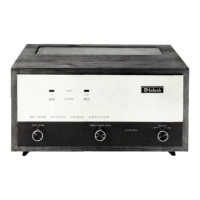INPUT
STEREO OR TWIN AMPLIFIER OPERATION
Use shielded cables to connect the signal from the pre-
amplifier or signal source to the power amplifier input. To
minimize the possibility of hum the shielded cables should
be run parallel to each other or loosely twisted together.
Locate the cables away from speaker leads and AC power
cords. All connections are made on the back panel of the
MC 2200.
For stereo operation, the left output of the preamplifier
should be plugged into the Left input jack of the power
amplifier. The right output of the preamplifier should be
plugged into the Right (MONO) input jack of the power
amplifier.
For twin amplifier operation a separate signal source can
be connected to each input. In stereo or twin amplifier
operation the MODE SWITCH must be in the STEREO posi-
tion.
MONOPHONIC OR SINGLE CHANNEL OPERATION
A shielded cable from the signal source is plugged into
the Right (MONO) input jack of the MC 2200 only. The
MODE SWITCH on the back panel of the amplifier must be
placed in the MONO position. In the MONO position the
right channel input jack connects to both left and right
power amplifiers. Mono output is obtained by strapping
both outputs in parallel. The Left INPUT is disconnected.
Only the signal fed into the Right (MONO) input will be
amplified.
Should the MODE SWITCH be left in the STEREO position
and the output transformers remain strapped for a mono-
phonic load, one channel will attempt to drive the other
which causes high circulating currents and overheating. Be
certain that the MC 2200 is never operated in the stereo
mode with the outputs connected for monophonic opera-
tion.
OUTPUT
Be certain the loudspeakers connected to the MC 2200
are capable of handling the power output of the ampli-
fier.
For multiple speaker operation, run separate leads from
each speaker to the amplifier. Because of the high power
available from the MC 2200, large diameter speaker leads
must be used. Use lamp cord, bell wire, or wire with similar
type of insulation to connect the speakers to the amplifier.
In all cases, the leads to and from the speaker should be
twin conductor or twisted together. When using 8 ohm
speakers and for the normally short distances of under 30
feet between the amplifier and speaker, #18 wire or
larger can be used. For distances over 30 feet between the
amplifier and speaker use larger diameter wire. Select the
correct size wire for the wire distance from the chart. It is
recommended that the DC resistance of the speaker leads
be less than 5% of the speaker impedance. Up to 10% can
be tolerated. Resistance of the leads should be computed for
the length of wire both to and from the speaker or speakers.
Wire
Gauge
22
20
18
16
14
12
10
MAXIMUM WIRE
For 4 Ohm Load
Feet
6
10
15
25
40
60
100
Meters
1.83
3.05
4.57
7.62
12.19
18.29
30.48
LENGTHS
For 8
Feet
12
20
30
50
80
120
200
Ohm Load
Meters
3.66
6.10
9.14
15.24
24.38
36.58
60.96
Wire lengths above represent the wire resistance equal to
5% of the speakers impedance. Use of smaller wire sizes
will produce more resistance which causes more power
loss and less loudspeaker damping.
STEREO OR TWIN AMPLIFIER OPERATION
Check the impedance of the speaker which is usually
identified on the speaker itself or in the speaker owner's
manual. Connect a lead from the common terminal of the
left speaker to the amplifier LEFT OUTPUT terminal strip
COMmon screw. Connect another lead from the other termi-
nal of the left speaker to the screw with the number cor-
responding to the speaker impedance on the LEFT OUTPUT
terminal strip. The right channel speaker is connected in
the same manner on the RIGHT OUTPUT terminal strip. For
stereo or twin channel operation it is not necessary to use
the same impedance loudspeaker on each output. Connect
4

